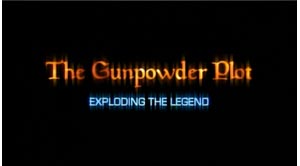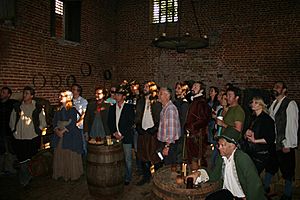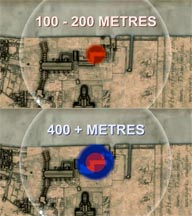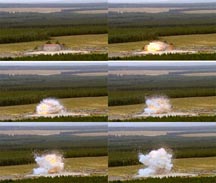The Gunpowder Plot: Exploding the Legend facts for kids
Quick facts for kids The Gunpowder Plot: Exploding the Legend |
|
|---|---|

The title screen for The Gunpowder Plot: Exploding the Legend
|
|
| Genre | documentary |
| Created by | Darlow Smithson Productions, Ltd. |
| Directed by | Mike Slee |
| Presented by | Richard Hammond |
| Theme music composer | Richard Attree |
| Country of origin | United Kingdom |
| Production | |
| Executive producer(s) | Richard Battin |
| Producer(s) | Mike Slee |
| Production location(s) | UK, Spain |
| Editor(s) | Ross Bradley |
| Camera setup | Lee Butterby Peter Allibone Chris Bryant Mike Craven Todd Dave Baillie (aerial photography) |
| Running time | 104 min. |
| Release | |
| Original network | ITV |
The Gunpowder Plot: Exploding the Legend is a British TV show. It was hosted by Richard Hammond. The show recreated parts of the famous Gunpowder Plot. This was a plan by Guy Fawkes to blow up the House of Lords.
The show first aired in 2005 on ITV. It cost £1 million to make. The main part of the show was building a copy of the Houses of Parliament. They built it as it looked in 1605. This was the year of the Gunpowder Plot. The original buildings were different from today's. They used old building methods to make the copy. Then, they filled it with mannequins. These represented important people and the king. Finally, they set off a huge explosion. The show was made to mark 400 years since the original plot.
Contents
What Was the Gunpowder Plot?
This TV show explores the Gunpowder Plot itself. It also looks at the people involved. The show answers a big question: Would the plot have actually worked? The answer was a clear yes. The Houses of Parliament would have been completely destroyed. Many windows in nearby Westminster Abbey would have shattered.
Rebuilding History: The 1605 Parliament
The first challenge was to rebuild the 17th-century Parliament. The original buildings were torn down long ago. Simon Carter, a Parliament expert, provided old drawings. These drawings helped them build the copy. They used 650 tonnes of concrete for the structure.
Explosives expert Sidney Alford helped. He figured out that 36 barrels of gunpowder were used in the plot. This was about one cubic ton of powder. Alford also showed that "decayed" powder could still explode. It was only bad for infantry use.
The Big Explosion Experiment
The experiment was a huge event. It happened at the Spadeadam test site. Experts from Arup watched over it. The test proved that the explosion would have killed everyone. This included King James I and other important people. They would have been at the State Opening of Parliament.
The power of the blast surprised even experts. It destroyed solid concrete walls. These walls were 7 feet deep. They were built like the old House of Lords walls. Measuring devices inside the chamber were also destroyed. The skull of the mannequin representing King James was found far away. It had been on a throne inside the chamber.
The show found that no one within 100 meters would have lived. All windows far from the palace would have broken. This included the stained glass windows of Westminster Abbey. The explosion would have been heard five miles away. It could be seen from much further. Even half the gunpowder would have killed everyone inside the House of Lords. The blast would have mostly gone upwards. This would have rained debris over a 200-meter area.
What if the Plot Succeeded?
The show also looked at what might have happened if the plot worked. This is called "what if" history. The plotters wanted to create a Catholic monarchy. They hoped to put King James's nine-year-old daughter, Princess Elizabeth, on the throne.
One expert thought English history might have been like France's. A president might even live in Buckingham Palace today. However, the expert also said the outcome would likely be the same. The plotters would still have been caught and punished. If the plot worked, there might have been a massacre of Catholics. They made up only 5% of the population. This could have meant no Catholics left in England.
The expert concluded that the plot was a "stupid" plan. He said, "you can't change the politics of a whole country just by blowing up a few hundred people."
Who Was in the Show?
- Richard Hammond - Host
- Justin Pollard - Historical Consultant
Historical Dramatization Actors
- Henry Douthwaite as Guy Fawkes
- Stuart Liddle as King James I
- Matt Rozier as Robert Catesby
- Jonathan Dunstan as Thomas Winteur
- Daniel Hoadley as Thomas Percy
- Toby Knight as John Wright
- Tallulah Boote Bond as Princess Elizabeth
- John Joyce as Father Henry Garnet
Making the Show

When Richard Hammond first heard the idea, he thought it was a joke. He couldn't believe someone would actually rebuild Parliament and blow it up.
The show took six months to make. It was very careful to be historically and scientifically correct. While research happened in England, Hammond and explosives expert Sidney Alford went to Spain. They needed to buy gunpowder. There wasn't enough in the UK. They were stopped at the French border by customs. Hammond said their expert had traces of explosives on him. This set off a security alert.
Hammond shared that the 2005 London Bombings happened during filming. This made the show feel different.
There were those who said we should stop our project, that it was insensitive. I disagreed. This is, after all, the story of a young man who felt persecuted in his country, who travelled abroad to learn how to use explosives and returned prepared to perpetrate an appalling act of terrorism - and if that rings a bell, so it should.
The production designer, Jo Manser, built part of the House of Lords. It was built to scale, just as it was in 1605. Then, they "blew it up to see if Guy Fawkes would have succeeded." The set was 11 meters by 23 meters and 16 meters high. It took 45 people to build it. The set cost £200,000. It was built between July and September 2005. Engineers checked the building plans for accuracy and safety. Manser noted that this was a very exciting way to get rid of a set!
For filming inside, they used 15 small digital cameras. For the outside explosion shots, they used a special slow-motion camera. This type of camera is not usually used for TV. It helped them study the explosions frame by frame.



